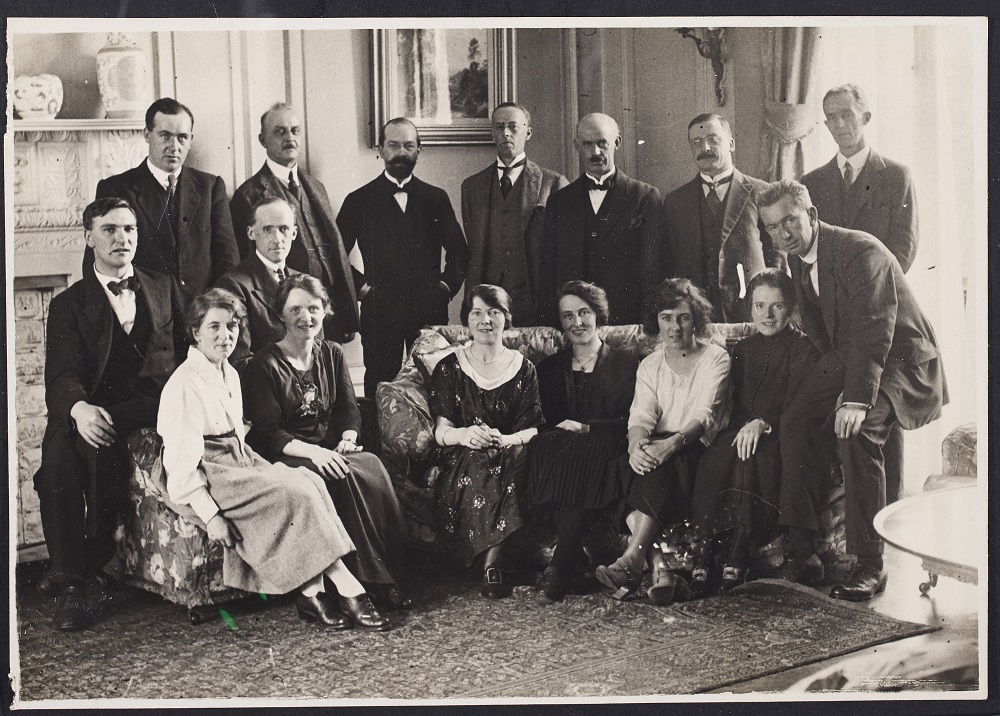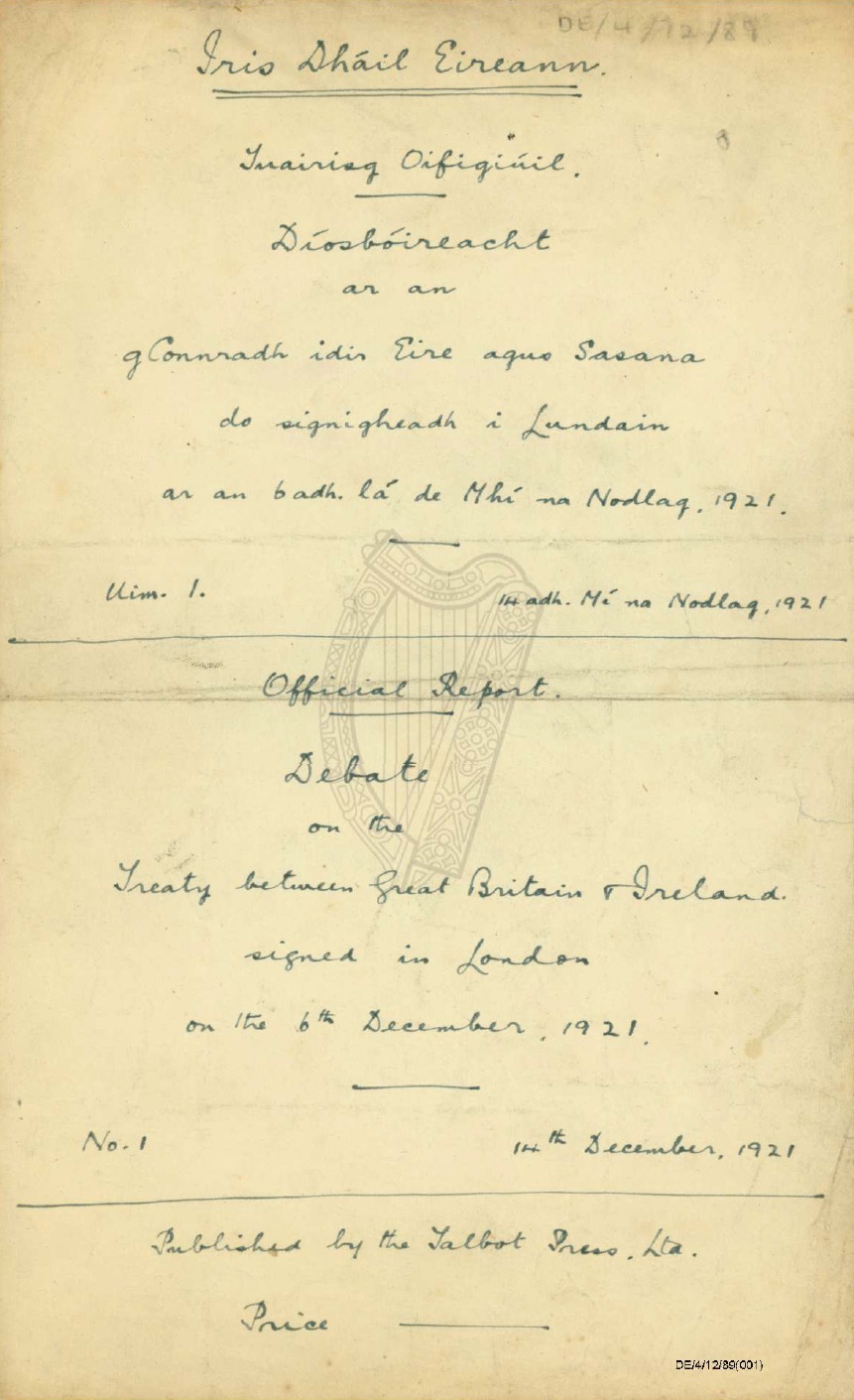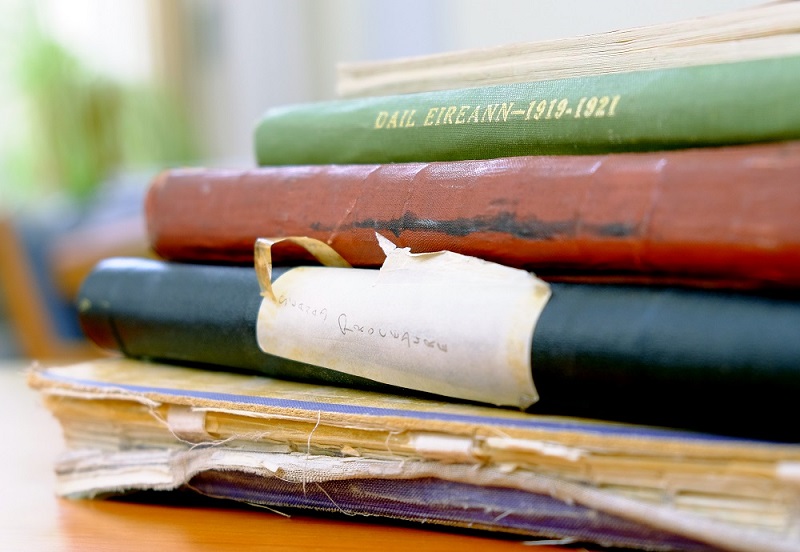The discussion on the Treaty was one of the most significant debates in the history of the Dáil. It was a crucial moment in Ireland’s history that set a new path for Ireland as a Free State. The task of producing the Official Report of the debates fell to Michael T. Knightly, a journalist who had fought in the Easter Rising.
In 1955, Ned Broy, one of Michael Collins's most important insider intelligence agents during the War of Independence, stated in a reference furnished for Knightly's application for a military pension:
Amongst other things, I learned from him [Collins] who were the persons he most deeply trusted during the fight for freedom. There were only a few. One of these was Michael Knightly.
Often when Michael Collins discusses important topics with me he would say: "I'll ask Mick Knightly", or "I'll get Mick Knightly to find out that", or "Mick Knightly thinks so and so" or "I'll get Mick Knightly to do that."
Michael Knightly was born at Ballyard, Tralee, County Kerry, in 1888. His father, also Michael, described in his obituary as a progressive farmer, was a prominent member of both the Land League and National League.
Educated at the CBS, Tralee, he began his career in journalism on the Kerry News and the Kerry Weekly Reporter. There he displayed exceptional shorthand accuracy and speed. In 1913, he moved to the Cork Free Press, where he became chief reporter and then to the Irish Independent the same year.

Michael Knightly (back left) with other staff in London for the Treaty negotiations, 1921 | Courtesy of the National Library of Ireland
In Dublin, he shared a flat with Thomas Ashe and in 1913 joined F Company, 1st Battalion, Dublin Brigade of the Irish Volunteers. A week before the Easter Rising, Knightly went to the offices of the Irish Working Journalists Association on Abbey Street, of which he was president, where he came across a clandestine meeting between Piaras Béaslaí, Commandant Ned Daly, Tom Clarke's brother-in-law, and Frank Fahy, who were "going over a Dublin street map". He was invited to join the meeting and asked if he would turn out the following Sunday for full mobilisation. This suggests Knightly was a close confidant, if not a member of, the Irish Republican Brotherhood.
After some initial confusion on Easter Sunday, due to Eoin MacNeill's countermanding order cancelling all Volunteer activities, Knightly made his way to the GPO to join his battalion where Seán MacDermott vouched for his credentials. Initially placed in a makeshift mess kitchen, he was eventually given a rifle and put on sentry duty, along with Noel Lemass. He also shared tea in the GPO with a fellow Tralee man, J.J. McElligott, future Secretary of the Department of Finance and architect of the Civil Service, who was on sentry duty on the roof.
Succumbing to a throat infection, Knightly was moved out of the GPO on Thursday, 27 April, to Jervis St. Hospital. Offered a chance to escape by a hospital doctor, he declined, stating he could not desert his comrades. He was interned in Richmond Barracks, where he became friends with Dick McKee, and then shipped to Wakefield prison and then Frongoch internment camp.
On his release towards the end of 1916, he returned to his job in the Irish Independent. Knightly had lodgings at 11 Great Denmark Street during the course of the War of Independence. Some of his fellow lodgers, Seamus Kavanagh and Tom Kissane, made up the Active Service Unit involved in the attempt to disarm a British Army ration party on North King Street on 20 September 1920 which led to the capture and subsequent execution of Kevin Barry. Kathleen Barry approached Knightly seeking information on her brother's arrest. He informed her that:
Of course you understand the position is serious. Two Tommies are dead and he is likely to be tried for his life.
Knightly procured several photographs of wanted men from the archives of the Irish Independent for "Headquarters". The two most prominent were Captain J.C. Bowen-Colthurst, responsible for the murder of Francis Sheehy Skeffington, Thomas Dickson and Patrick McIntyre at Portobello Barracks during the Easter Rising, and Alan Bell, RM.
On 8 March 1920, Alan Bell, began to preside over a Star Chamber court in the Dublin Police Court buildings, to ascertain the whereabouts of Sinn Féin and Dáil Éireann funds, as well as the growing Republican Loan which Collins had concealed in various banks. Previously as an RIC inspector, Bell had been successful in shutting down various funding sources for the Land League. Collins was unnerved by Bell's investigation and demanded he be dealt with quickly. Knightly provided the only available photograph of Bell to "Headquarters". He stated later in 1953 in his Bureau of Military History witness statement:
On the 27th March, while down the country on reporting work, I got rather a shock when I read in a morning newspaper that Mr. Bell had been taken from a tram at Ballsbridge and shot. I wondered if the photograph had been used for the purpose of identification.
Three weeks later I was sentenced to a month's imprisonment for refusing to allow the British to photograph me. They had wanted to take my finger prints, but I said that they would have to do it by force.
It was only a matter of time before Knightly would come to the attention of the British authorities. A reporter from The Irish Times described the level of detail in Knightly's Evening Herald report of Robert Barton's escape from Mountjoy as not surprising as he was a Frongoch man. The reporter subsequently joined the Hansard staff in Belfast.
After a raid on his lodgings in 11 Great Denmark Street, Knightly was imprisoned for one month in Mountjoy Prison. He stated:
Three weeks later I was sentenced to a month's imprisonment for refusing to allow the British to photograph me. They had wanted to take my finger prints, but I said that they would have to do it by force. They did not try force and confined the charge to a breach of the Defence of the Realm Regulations. My reply was brief. It was that I denied the right of a foreign government to make regulations governing my actions in my own country.

Draft handwritten outline of the title page of the Dáil debates on the Treaty | National Archives of Ireland (CC BY-NC-ND 4.0)
As well as intelligence work, Knightly continued to work as a journalist, often having scoops of various events in the War of Independence in Dublin. He covered the East Cavan election with his reports of various speeches used to counter Dublin Castle censorship. He recorded Sinn Féin meetings in shorthand and reported the First Dáil's Commission of Inquiry into the Resources and Industries in Ireland. In 1921, he travelled to London with the staff of the Treaty delegation, as a press reporter.
Subsequently, he became the official reporter of the Treaty Debates. He then was appointed first Editor of Debates of the Houses of the Oireachtas, a post he held until 1955, apart from the Emergency, when he was the Chief Press Censor. He retired in 1955 and moved to Dunmore, County Galway. In his obituary, it was noted he was a close friend of Éamon de Valera, Michael Collins, Arthur Griffith, Austin Stack and other prominent Sinn Féin members from the War of Independence.
History of the Debates Office
The Debates Office was established in 1922 to produce the official report, and it continues to do fundamentally the same job today. You can find out about parliamentary reporting through the decades on the Dáil100 website.


